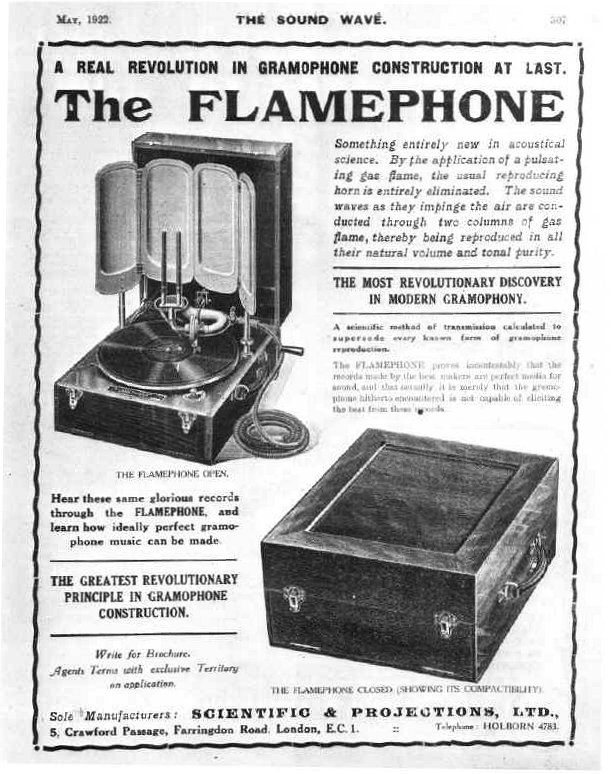Gallery opened 31 Mar 2021
Updated 2 Apr 2021




The Flamephone |
Gallery opened 31 Mar 2021 |
THE FLAMEPHONE
Singing arcs and flame loudspeakers are fairly well-known, but this device appears to be a unique combination of flame loudspeaker and gramophone. Here the flames do not generate the sound; that comes from a conventional horn, then passes through the flames, whose amplitude is modulated by the sound. In a true flame loudspeaker the electrical signal is applied directly to the flame by electrodes.
 | Left: An advert for the Flamephone: May 1922
|
Review published in Gramophone for Oct 1923
"WHEN we invited Scientific and Projections Ltd, of Crawford Passage, Farringdon Road, London, EC 1, to send a Flamephone to this office for our tests of portables we did not know that it was beyond the scope of the tests owing to its price and also because, though it is portable, it requires gas in order to obtain its especial effects, and is therefore hardl in the class of gramophones that can be carried and played anywhere. However, the makers very kindlv sent us a model of thc "semi-portable type" to see, and we are extremely grateful to them for having given us a chance of examining what is certainly a most interesting, and even exciting, invention. In a fine mahogany case it costs £17 lOs. and weighs 22lb, and when put together is a distinctly handsome machine. But the fittings which make it specifically a Flamephone can be put on to any ordinary gramophone for £6, and this fact removes the invention at once from the realm of fantastic gadgets. It deserves the serious consideration of all gramophonists.""To quote from the description of it, "the mica diaphragm in the sound box is associated on one side with the horn, the mouth of which is directed upwards, and at the other with a gas chamber leading to two small upright burners, which are perforated with a number of very fine holes, gas being led into the chamber by a small rubber-tube attached to a cock at the back. The gas jets are directed horizontally across the mouth of the horn." There are a hundred jets, and in a darkened room these are very pleasantly reflected in the aluminium shield which protects the woodwork and also acts as a sounding-board. By a simple balancing device the weight of the soundbox and horn on the record can be adjusted to suit individual taste." "Mr Kitchen's invention is founded on the fact that a gas jet is extremely sensitive to sound waves over a very wide range, and it is claimed that though the flame-phone without any gas has a quality of tone "comparable with that of the average gramophone" the effect of turning on and lighting the gas is not only to augment the sound but to improve the quality of the tone in a wonderful way. There can be no doubt about this improvement in volume and in tone. By many experiments of turning the office gas on and off as we tried the various records we satisfied ourselves that in some mysterious way the vibrations of the gas jets had a clarifying and strengthening influence on the soundbox." "The clearness of the tone was even more evident when the Flamephone was contrasted with the Orchestraphone in the office, which for the moment appeared to be almost woolly; and if a long length of tube were not required in order to have the Flamephone out in the garden, one would say that it would be at its very best in the open air at night, with the picturesque illumination of the gas-jets. On the whole, however, we felt that for normal purposes indoors it was slightly hard- not by any means harsh in tone; it was not so comfortable, for instance, as the Orchestraphone; but this must be largely a matter of individual taste, and it can at any rate hardly be doubted that the Flamephonc principle applied to one's favourite make of gramophone would improve it. It is the principle rather than the semi-portable model submitted to us which won our respectful admiration, and the fact that a demonstration before the Royal Societv was. we are told, greeted ∑with unqualified approval, inclines us to recommend our readers to take an opportunity of judging the Flamephone if possible. Evidently this is one ofthosc inventions which cost a good deal to start, but which, if able to establish themselves, may be offered to the public subsequently at a much reduced cost." C. R . S. |
Source: Review published in Gramophone for Oct 1923 (edited by Compton Mackenzie) The identity of author CRS is unknown.
From this we learn that "The gas jets are directed horizontally across the mouth of the horn." and that there are "...a hundred jets, and in a darkened room these are very pleasantly reflected in the aluminium shield which protects the woodwork and also acts as a sounding-board." It's not clear to me how thin aluminium reflectors are going to act as a sounding board in any way.
Also we hear that "By many experiments of turning the office gas on and off as we tried the various records we satisfied ourselves that in some mysterious way the vibrations of the gas jets had a clarifying and strengthening influence on the soundbox.". It is well-known that in non-blind comparisons people are very likely to perceive what they expect; it is called the experimenter expectancy_effect, and that seems to have been what happened here. It hppens all the time in hifi reviewing today, leading to pages of fabricated drivel. There seems to be no way in which putting sound through a modulated gas flame could improve its quality.


  
|